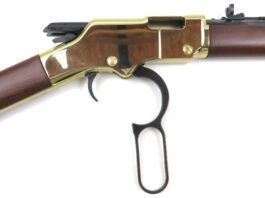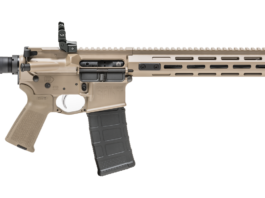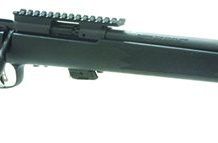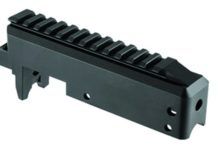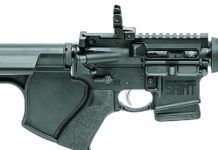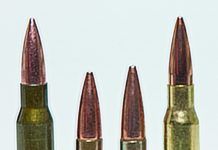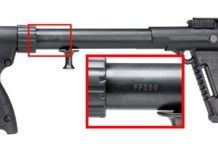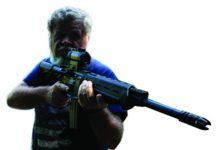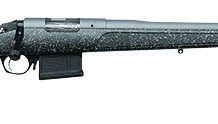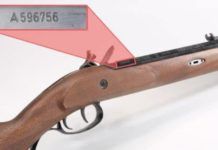VALUE GUIDE: Centerfire Bolt-Action Rifles (Multiple Chamberings)
Log on to Gun-Tests.com to read complete reviews of these products in the designated months. Highly-ranked products from older reviews are often available used at substantial discounts.
Rifles Not Ready for 50 States
Please consider the following. The issue of gun control, regardless of degree, is a cultural issue — not a national safety issue. When the Constitution was written, less than 15% of our population lived in urban areas. Today, approximately 80% of our population is urban. However, cities account for only about 5% of the geographical landmass of this country. We now have two opposing gun cultures in this country — with urbans believing guns are only for killing people and rurals viewing them as tools, much as a rod and reel are for fishing.
Threaded-Barrel Rimfire Rifles: Savage, CZ, and Ruger Compete
As we noted a couple of issues ago, the shooting community is seeing more and more factory-supplied threaded barrels on rifles to allow application of muzzle devices, including sound suppressors. In that previous test of 308 Winchester and 300 Blackout bolt rifles, we noted generally better accuracy with the rifles when fitted the cans, but we didn't cover how much more pleasant the centerfire rifles were to shoot. Our shooters noted a marked difference in recoil at the shoulder, and, perhaps more profound, the lack of muzzle blast and report created better shooter conditions behind the gun. A lot of things can contribute to flinching and missing, and noise and a sharp push into the shoulder are two of them.
This time, we cut way down on the noise — to practically nothing, which has its own appeal — by shooting three rimfire bolt-actions side by side with a suppressor. We realize one of the drawbacks of shooting quieter is the initial cost of the cans as well as the red tape. We can't do much about the red tape other than to say get yourself an NFA trust, depending on where you live. But we can offer a strategy for making the can work across many firearms, so you can amortize its cost per shot. But first, the rifles.
We ordered all three rimfires online. The rifles, a Ruger American Rimfire, a CZ-USA 455, and a Savage MKII FV-SR, were delivered in less than a week to 2nd Amendment Arms and Ammo in Katy, Texas, a preferred Bud's FFL who charges only a $10 transfer fee per gun with a Texas License to Carry and $20 per gun without the TLC.)
Our first test rifle was a Ruger American Rimfire Standard 8305 22 LR, $309. Ruger's American Rimfire line is already extensive, and new models will build it out further. The 8301 is similar to our test 8305 model, with the former having a barrel length of 22 inches rather than the 18-incher on our rifle. Other 22 LR chamberings in the line include the 8351, which has an 18-inch stainless tube; the Talo Distributor Exclusive 8331, which comes with a Muddy Girl Camo Synthetic stock; and The Shooting Store Distributor Exclusive Model 8334, which has an OD green synthetic stock that contrasts with the black comb modules. Other chamberings include 17 HMR (Model 8311 with a 22-inch barrel; Model 8312 with an 18-inch barrel) and 22 WMR (Models 8321 and 8322, with 22- and 18-inch barrel lengths, respectively).
Our second rifle was the CZ-USA 455 American Synthetic Suppressor-Ready 02114 22 LR, $373. Like the Ruger, the CZ 455 02114 is part of a sizable line of rimfires offered by the Kansas City, Kansas-based importer. Among the other offerings in the 455 line are the CZ 455 American Combo Package, which comes in 22 LR and also ships with a 17 HMR barrel, along with everything you need to make the caliber change. Other interesting models include the 455 American Stainless, which comes with a swappable 20.5-inch barrel finished in a matte bead blast. For those of you who don't foresee ever buying a suppressor, the American Synthetic is similar to our test gun but is not suppressor-ready. The price difference is so small, $421 for the threaded rifle and $385 for the non-threaded barrel, we don't see the value in the threadless version.
The third rifle was the Savage Arms MKII FV-SR Threaded Barrel 28702 22 LR, $248. The shooter may wonder if the $248 price suggests that this rifle is cheap. It is inexpensive, but not cheap. One example of value was the receiver-mounted Picatinny top rail, which allowed us to pop on a Nikon scope with ease and bore-sight the rifle in minutes. Very handy. Also, there's the adjustable AccuTrigger, which came out of the box at 2.4 pounds.
July 2018 Short Shots: Rifles and Rifle Accessories
Brownells recently rolled out the BRN-22 Receiver for custom rimfire rifle builds. The BRN-22 is fully compatible with the popular Ruger 10/22, so you can choose from the many barrels, stocks, triggers, and other custom components for the 10/22 platform. According to the Brownells website, the BRN-22 receivers are machined from 6061 aluminum billet "to exacting tolerances." Brownells touts the machined receivers as better than forged, and points to the smooth, clean interior "to realize that a machined receiver can be held to much tighter tolerances for a precise fit with other parts." After machining, BRN-22 receivers get a matte-black Type 2 hardcoat anodized finish.
Rifles Ready for All 50 States: Springfield, Troy, and Uintah
Innovation in firearms design has always meant finding a way to make guns more accurate, more reliable, less expensive to produce, and for the end user, easier to operate and maintain. And when it comes to trying to satisfy the restrictive demands of different state laws, the word innovation can once again be applied. Naturally, we'd like to see talented people work toward solutions without so much regulation, but we also wondered if makers seeking ways to satisfy the legalities of certain policies, a better firearm, or at least a promising new design, would emerge.
For insight into the world of regulated firearms manufacture and sale, we visited Todd and Amy Arms & Ammo in Petaluma, California. A family-owned full-service gun store run by retired Marine Todd and his wife Amy, their bustling shop serves as the epicenter of gun goodies in the more-gun-friendly area of Northern California. At Todd and Amy's, we learned that several inventors have been tackling the problem of providing workable solutions to producing 50-state-legal long guns for some time, including fixed magazines, variations on the pistol-grip stock, and even pump-action designs. In this test, we will look at three production rifles that incorporate elements of AR-type-restricted design found in states such as California, New York, Maryland, New Jersey, Illinois, and others. Because of constantly changing laws in these states, you must know your local regulations to see if a particular rifle conforms to your state's regulations. We do not guarantee these firearms will remain legal to own in any state, so check before you buy.
Our first choice was the $1135 CA Compliant "AR-15" Saint from Springfield Armory chambered in 5.56mm/223 Remington and featuring a full-float barrel.
Next was a pump-actuated "AR-10" from WorldofTroy.com chambered in 243 Winchester. List price of the Troy Pump Action Hunting Rifle was $899.
Our third test gun was a full-length bolt-action rifle from Uintah Precision chambered for 6.5 Creedmoor. Why is a bolt-action rifle in this review? Because the threaded barrel, upper, and handguard are configured as an AR platform that was designed to fit an AR-10 lower. Uintah sells the upper alone for $1295, but they were able to supply a matching lower so we had a complete rifle for our tests. Therefore, in the Uintah's specifications chart, the term "as tested" denotes measurements taken for the upper receiver only, as your lower may vary.
For ammunition supply we relied heavily on new selections from Black Hills Ammunition. Black Hills is a family-owned business that came to prominence by developing a 223 Rem. load topped with Sierra's 77-grain bullets for the U.S. military, therefore vastly improving the stopping power of the select-fire M16 rifle and its semi-auto civilian-version AR-15. Our Springfield Cal-legal Saint was stoked with four different rounds manufactured by Black Hills ammunition, ranging in bullet weight from 60 grains to 77 grains. Much of Black Hills production still relies heavily on military contracts, and this stamp of approval is why we so often favor their ammunition.
Black Hills has lagged noticeably behind other makers in offering 6.5 Creedmoor (or 6.5 CM) commercially, and now we think we know why. As of this writing, it has been announced that SOCOM, i.e. USSOCOM (Special Operations Command), is evaluating chambering 6.5 Creedmoor and phasing out the use of 7.62x51 (308 Winchester) ammunition in AR-10-type rifles. The Uintah rifle was fed Black Hills 143-grain and 147-grain ammunition, plus 140-grain rounds loaded by Hornady. Our pump-action Troy rifle was treated to three rounds from Black Hills Ammunition, each topped with Hornady bullets. The 243 Winchester ammunition featured Hornady's 95-grain Hornady SST, 80-grain GMX, and 58-grain A-Max bullets.
To ensure that our rifles had the benefit of high-grade optics, we relied upon the Nightforce ATACR 5-25x56mm SFP Enhanced riflescope (No. C554), featuring 0.10 Milradian click adjustments and extraordinarily clear glass. The reticle was illuminated by pressing the button at the center of the parallax adjustment turret, but "Enhanced' might very well refer to the interaction of the big, bold reticle constructed with fine lines, maximizing the capabilities of second-focal-plane design. Overall construction was robust, but relatively compact. We also tried out the Nightforce SR 4.5x24 Competition riflescope designed for the High Power Service Rifle division when it occurred to us that the California Legal Saint AR-15 may be the gun of the future for competitors in California.
Threaded-Barrel Bolt Guns In 300 Blackout and 308 Win.
A few years ago, the incidence of factory-supplied threaded barrels on rifles was negligible, because most people didn't have a lot of interest in changing their muzzle devices, including flash suppressors and sound suppressors. Sound suppressors, also incorrectly known as silencers, and more accurately called "mufflers" or "moderators," just weren't that common because the devices were regulated by the National Firearms Act (NFA) of 1934. In that law, Congress used its tax power to set up a tax-and-registration system for machine guns, short-barreled shotguns and rifles, grenades, mortars and various other devices, including sound suppressors.
Under the NFA today, a prospective owner must go through a months-long registration process with the Bureau of Alcohol, Tobacco, Firearms and Explosives (BATFE) and pay a $200 tax, in advance, before he or she can purchase a suppressor. Despite the difficulties posed by the regulatory system, suppressor sales have continued to grow over the last decade, and especially the last five years. Suppressor ownership is legal in most states. The exceptions are Hawaii, California, Illinois, New York, New Jersey, Delaware, Rhode Island, and Massachusetts. In the 42 states where suppressors are legal, they are allowed for hunting in all but Connecticut and Vermont, and states are de-regulating suppressor use every day, so this list may be outdated by the time you read this.
Concurrent with the sales growth of suppressors, manufacturers have responded by making the muzzles of some of their rifles and pistols easier to receive the devices. Thus, the growth of factory-threaded barrels, three models of which we recently tested, with and without a suppressor.
Attention: Important Kel-Tec Sub-2000 Safety Recall Notice
According to a Kel-Tec statement, an issue with the "heat treatment of certain steel tubes received from a third‐party supplier from which the barrels for a limited number of Kel‐Tec SUB‐2000 rifles were manufactured," may rupture the barrels when firing cartridges. The safety of our customers is our primary concern, so Kel‐Tec has voluntarily initiated this recall because of the possibility of a barrel rupturing."
Affordable Home-Defense Rifles: AR-15 or M1 in 30 Carbine?
When we evaluate firearms, there are guidelines we follow. Some of the projects are a result of market forces, where we are guided by what is new in the market place. Then there are reader requests. The following evaluation combines those arenas. Readers have shown interest in the M1 30 Carbine because it is a lightweight, handy rifle with historical overtones that shooters of a certain age respect. Accordingly, we have done comparisons of the rifles head to head and also ammunition testing.
Likewise, we have extensively tested AR-15 rifles and ammunition. So, coupled with experience in handling both rifles and the preference of some of the raters, we cooked up an AR-15 versus M1 Carbine shoot-out, with a slant toward inexpensive rifles for home defense. The M1 Carbine is fairly inexpensive in most examples, including good-quality modern reproductions such as the Auto Ordnance. Until very recently when regulatory bans began pointing anew at the semi-auto rifle, the AR-15 had been increasingly affordable, and we even saw something of a price war going on as late as January 2018. So, with a budget theme in mind, we chose two rifles for a new shooter on a budget and limited the spend to $800, including a reasonable number of magazines and a credible ammunition supply. Counted in this evaluation were the opinions of inexperienced and female shooters, the latter of which we listened to carefully to find a combination of recoil, muzzle blast, and firearm weight the distaff gun owner might prefer.
Some prefer a long gun for home defense for its power and accuracy, and the fact that handguns require time and inclination to master, a rifle can be an easier-to-learn tool, especially if area defense is also a consideration — that is, your yard is pretty large or if roaming predators, such as coyotes and feral dogs, are a consideration. A hard-hitting but light-kicking rifle can give results much beyond what a handgun can do for most shooters, if the rifle is reliable and accurate enough.
The ammunition testing we have previously done in each caliber is an important part of the summary of facts in this feature. In terms of power, the 30 Carbine round in its most-common size, 110 grains, runs slightly behind the standard 223 Remington in a 55-grain bullet. But power isn't the only consideration for someone using a rifle inside a home. Too much penetration is a problem. Choosing the right round is crucial to balance what's needed to stop the fight and what's too much. In previous tests, we found the Hornady 110-grain Critical Defense 30 Carbine round produced 1980 fps and the resulting energy of 957 foot-pounds. Shot into water, that round terminated with an expanded width of 0.47 inch and weight retention of 100%. It penetrated 20 inches of water. A Hornady V-Max 223 Remington load with a 55-grain bullet sped along at 2890 fps and produced muzzle energy of 1019 foot-pounds. That might worry the home defender, but this particular round finished with an expanded width of 0.44 inches of the largest fragment. It retained 50% of its weight and only penetrated 10 inches in water. The AR, again, has the edge because it's possible to tailor the load to the home, and that's not as feasible with the 30 Carbine rounds.
How do these rifle rounds stack up to some common handgun loads? They're much more powerful. As noted above, the 30 Carbine Hornady FXT generates muzzle energy of 957 foot-pounds and the 223 Hornady V-Max 1019 foot-pounds. In comparison, a Double Tap 10mm 135-grain round generates 1555 fps and 725 foot-pounds of energy. A Black Hills 357 Magnum 125-grain round running 1430 fps makes 567 foot-pounds of muzzle energy, and a Black Hills 45 ACP 230-grain JHP clicking along at 850 fps makes a paltry 369 foot-pounds of muzzle energy.
So with those facts in mind, we compared an Israeli Arms International M1 30 Carbine and a home-built AR-15. Average price at outlets was $480 for the 30 Carbine. Also, we found a Universal Carbine in a local shop for $425, and average price for a new Auto Ordnance 30 carbine was $775. We found a new Del-Ton AR-15 for $399 new in the shop. There are many good AR-15 rifles going begging at the beginning of the year for $600 and less. This is a turnaround from a year ago. So, a clear winner on the price scale goes to a budget AR, at least until a new buying boom changes that. For more stable pricing, we chose to test a gun we built ourselves. The test AR-15 rifle consists of an Aero upper and receiver, Brownells barrel, and Brownells bolt. The parts priced out to $600, and we got what we consider to be an average rifle with good components. We realize you can go as high as you want on the AR-15 and spend several thousand dollars, but that isn't what we are doing in this report.
New Rifle Introductions for 2018
Gun Tests reporters and editors on the scene at SHOT Show 2018 in Las Vegas scoured the show for new rifle, pistol, shotgun, and accessory entries for our readers to consider this year. For what seems like a long time now, new rifle introductions have been dominated by variations on the AR-15/AR-10 platform. But for 2018, we're also seeing the emergence of more dedicated long-range precision sport and hunting rifles. Here's a rundown on quite a few just-introduced rifle choices for 2018, some of which we'll be looking at later this year.
Lyman Recalls Black-Powder Rifles and Pistols
Gun Tests has learned that Lyman Products Corp. ("Lyman") is voluntarily recalling black powder rifles and pistols due to the potential of separation in the breech plug.
Bolt-Action Hunting Rifles for Compact and Youth Shooters
Not every shooter averages 6 feet in height. Some people are physically closer to tank drivers than football defensive ends. With children and the increasing number of women participating in the shooting sports and in the hunting fields, there is growing need for rifles for more compact shooters. Therefore, we tested three compact centerfire hunting rifles in three short-action chamberings: the Browning A-Bolt Micro Hunter in 7mm-08 Remington, the CZ 527 Carbine in 7.62x39mm, and the Savage Axis II Compact in 243 Winchester.
As usual, we shot each rifle with three different kinds of ammunition. After sight in and chronograph testing with the Magnetospeed V3 chronograph, we shot five 5-round groups with each kind of ammunition from the bench using a Caldwell FireControl rest. Our shooting panel was a little differently configured than usual. Along with some of the usual testers, we had a youth group ranging from 8 to 17 years of age participating. You can imagine our fun with this enthusiastic group of testers! We also included some experienced women shooters. These two groups provided useful and sometimes surprising input. As two very different types of shooters tested this rifle, we will provide two sets of recommendations to reflect the different needs and experience of each type of shooter. Let's see if one of these rifles belongs in your gun safe.
Ruger Precision Rimfire: 2018 SHOT Show
Gun Tests Editor Todd Woodard interviews Ruger's Director of Product Management Mark Gurney and learns about the company's Ruger Precision Rifle.





























